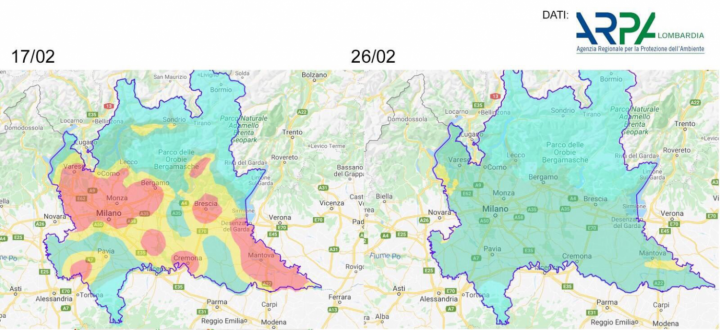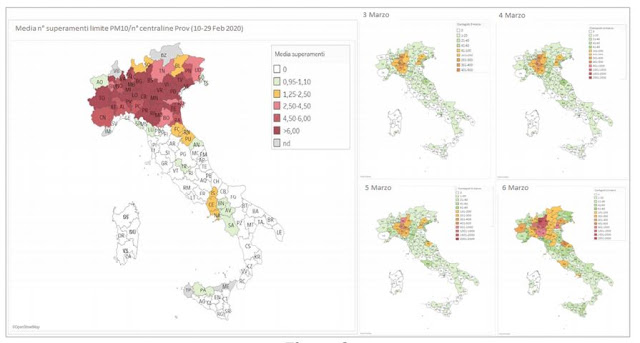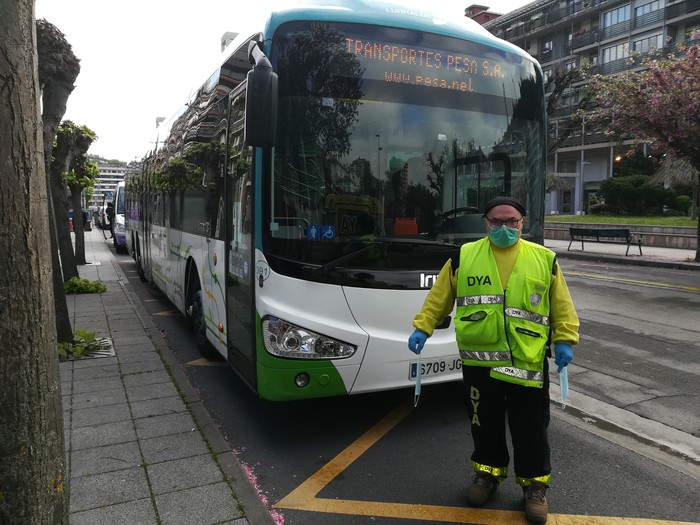It's no coincidence that the first outbreaks of Covid-19 plague are in heavily contaminated areas.
- As far as this scourge is concerned, it is no coincidence that there are the first outbreaks in China, Iran and northern Italy, situated in heavily polluted environments. We have come to a number of scientific sources who have spoken over the past few weeks about this very important aspect of the pandemic: ToxiWatch, European Alliance for Public Health, Ugo Bardi, Italian Association of Environmental Medicine, French Institute of Health and Medical Research...

The scientists of the Dutch ThoxiWatch Foundation (known in the ARGIA community for the information and interviews they have given us on our pages on waste incineration) sent us documents in the first days of the plague containment – 19 March – in which some relations between Covid-19 and air pollution were mentioned.
“Just a few months before the coronavirus appeared in the city of Wuhan, there were huge protests against incinerators, as can be seen in this chronicle of the English television BBC: ‘Wuhan: The incinerator project has been stirred up by people.’ Attached we send you a study on the existing incineration plants in Wuhan, in Photo 4 on page 8, which have used a lot in the presentations, where you can see how they manage the ashes. You can see a man working among those bags full of ashes, outdoors and at the mercy of winds. The ashes are heavily contaminated with dioxins and other POP.
A post-epidemic study showed that there is a connection between mortality and air pollution caused by the SARS virus that hit China in 2003.
Regarding COVID-19, on March 16, the European Alliance for Public Health (EPHA) has published the following article: ‘The threat of coronavirus is greater for polluted cities’.
Dear friends, a thousand hugs. Together we can try to make the world a little better, a little healthier.”
Fortunately, there are scientists and academics like ToxiWatch who prioritize serving society rather than raising their resume.

The EPHA article ‘The threat of coronavirus is greater for polluted cities’ states in essence. Dirty air minimizes the chances of survival of those affected by the coronavirus. Air pollution causes hypertension, diabetes, respiratory diseases and doctors who begin to see connections between these and COVID-19 deaths. A 2003 study in China showed that among the victims of SARS coronavirus, people in regions with moderate air pollution were 84% more at risk of dying than those living in areas with low pollution.
Air pollution causes hypertension, diabetes, respiratory diseases and doctors who begin to see connections between these and COVID-19 deaths
The European Breathing Association (ERS) is a member of this EPHA) has indicated that air pollution is the greatest risk to environmental health in Europe and that the biggest problem is in cities. Fine particulates (PM), nitrogen dioxide (NOadvanced) and ground-level ozone (Oš) are the most dangerous and cause 400,000 premature deaths each year. In this regard, according to the ERS report, Northern Italy is one of the black spots, the European centre for coronavirus attacks.
It is true that, according to the photographs taken by satellite, there has been a significant drop in pollution in Lombardy in recent weeks, mainly in terms of NO2 and PM10. However, EPHA has pointed out that dirty air has already done damage, as it has weakened people's ability to resist infection. It urges the authorities to immediately take the necessary measures to clean the air of cities in the face of the increasing frequency of pests such as Covid-19.
On March 22, Ugo Bardi published more information along the same lines in the article sent to the newspaper Il Fatto Quotidiano: “The coronavirus epidemic and pollution: Do they have a relationship?” The well-known chemist Ugo Bardi, a member of the Club of Rome, knows ARGIA from some of the articles we have translated and offered it to us from that Larruna with the fall of the Roman Empire. This time Bardi presented the study “Relazione circa l’effetto dell’inquinamento da particolato egurico e la diffusione di virus nella polazione”, published by Lenoardo Setti and other researchers in the journal of the Italian Society of Environmental Medicine (SIMA). In this sense, one can see a possible connection between the two phenomena in Italy.
It seems that particles can be used to transport the virus and accelerate its spread. “This may have to do with the higher rate of spread of plague occurring in the Val Padana region, probably the most polluted in Italy.”

The SIMA article – says Bardik – makes no explicit mention but also weakens the victims’ immunity systems, as we know from other studies. For example, a recent study shows that this virus prioritises the lungs of smokers in their attack and that smoking [tobacco] causes lung damage similar to pollution.
As expected, others have gone against those conclusions which, although considered likely, remain hypothetical, such as the Italian Aerosol Association (IAS), the employers of aerosol producers, which cites that the effects of SIMA doctors and researchers are basically “unproven indications”.
Bardi, who always tries to follow the line of science, says, listening to the two: here's a good example of how science progresses, we start by finding a correlation, often dubious, and then we come to an explanation. And it reminds Dr. John Snow, who became famous in the 19th century. Snow noted that the cholera plague that drowned London had to do with the sick people living near a certain fountain of the square. He closed the fountain and managed to control and contain the plague. Much later it was known that the water came from a pond contaminated by the flushing of toilets. So nobody knew that there was a bacterium. “If Snow had been waiting for a safe explanation, people would still drink from that source and die of cholera.”
And later on: “All this does not mean that pollution has been the cause of the plague, by any means. But it's an important factor to keep in mind. If the air in Lombardy had not been so polluted, the spread of the virus could have been more easily controlled and the number of deaths would have been lower.”
.jpg)
On March 31, the French magazine Reporterre interviewed Isabella Annesi-Maesano, head of research at the French Institute of Health and Medical Research (Inserm in the French acronym) and head of the epidemiology team of allergic and respiratory diseases at the Institut Pier-Louis and the University of Sorbonne. It says: “It is no coincidence that the first outbreaks of plague are located in heavily contaminated environments.” In his view, fine particles discharged by industry can be an important means of transporting the coronavirus, but also the large run-off taking place on the fields in agriculture and industrial livestock.
Here are some paragraphs taken from Isabella Annesi-Maesano, literally. SARS-CoV-2 (the scientific name of the coronavirus that we all know as Covid-19) gets into the nose and mouth to damage the lungs and can use as a means of transport the fine particles that are suspended in the air. If you look at the microscope at the 10 microns in diameter larger in fine particles, you see that they're able to carry viruses, pollen, spores, etc. Smaller particles, with a diameter of less than 2.5 microns, bind together by catching bacteria, spores, pollen, fungi, etc. between them SARS-CoV-2. Particles can go a long way: Scientific articles have shown that the remains of the desert contribute to the fertilisation of the Amazon rainforest with the organic materials it carries!
But the most important thing we should bear in mind is that contamination carries the virus and aerosol contamination is possible, although the transmission of the plague occurs mainly through a drop [thrown by the nose and mouth]. And that this kind of transmission by pollution not only occurs with SARS-CoV-2. This has already been seen in the plague SARS-CoV-1 in 2002-2003, but also with viral infantile bronchiolitis, influenza, bird flu, tuberculosis…
On the other hand, in the contaminated areas, the population is more vulnerable to infections. Air pollution irritates and destroys mucous membranes of the airways. As a reaction, the airways become more permeable and the pathogens are introduced more easily from the outside into the human body. In addition, fine particles cross the protectors of the pulmonary alveoli, reach the blood and attack all organs, causing systemic inflammation. Therefore, air pollution, in addition to causing various respiratory problems, also generates cardiovascular, neurological and metabolic diseases, cerebral infarctions, diabetes, obesity... Two out of three pollution-related diseases are cardiac! And if people are already sick, contamination further aggravates their pathologies, facilitating the possibility of being a victim of infections such as SARS-CoV-2.

The pandemic has revealed, in all its crudeness, the consequences of the neoliberal model of care for the elderly, children and the dependent population. Now is the time to consolidate the critical discourses and community alternatives that flourished during the lockdown.”... [+]






















